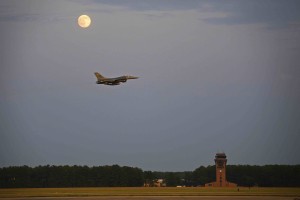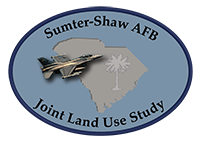The Sumter-Shaw AFB JLUS was developed by the JLUS consultant team in coordination with the Sumter  City-County Planning Commission, and under the guidance of two steering committees (a Policy Committee and a Technical Advisory Committee) with input from the general public. More information on the Policy Committee and the Technical Advisory Committee can be found under the “JLUS Partners” tab above.
City-County Planning Commission, and under the guidance of two steering committees (a Policy Committee and a Technical Advisory Committee) with input from the general public. More information on the Policy Committee and the Technical Advisory Committee can be found under the “JLUS Partners” tab above.
Public input was critical to the JLUS, and the community had multiple opportunities to provide information, ask questions, and provide comments. Public meetings were held throughout the JLUS process to inform the community of the study’s progress and to seek input for the deliverables.
The first meeting was held Monday, October 26, 2015 where the public participated in a live-polling exercise and the JLUS team introduced the JLUS concept and process to the community. The second meeting was held Monday, July 18, 2016 where the JLUS team briefed the public on their findings and received feedback on draft recommendations. The third and final public meeting was held on September 12, 2016 where the JLUS team presented the Policy Committee’s recommended Final Study for Shaw AFB and Poinsett ECR and to receive public comment and input on the report. Additionally, the public provided insight through the JLUS Public Survey, the results of which are included in the JLUS.
If you have any comments or questions, please feel free to post them on the Sumter-Shaw JLUS Facebook page, or contact the team at:
George K. McGregor
Planning Director/Project Manager
Sumter City-County Planning Department
gmcgregor@sumter-sc.com
(803) 774-1606
Ultimately, the Policy Committee made the final recommendations included in the study based on the input of the community and the assistance of the Technical Advisory Committee.
The Sumter-Shaw AFB JLUS included four major objectives:
- Reviewed and analyzed existing conditions. The JLUS was informed by the historical, current, and future growth patterns of the region. Understanding the current land use regulations, policy designations, permit tracking, and other development tracking elements was critical to the analysis.
- Reviewed and analyzed the effectiveness of the 1993 Shaw AFB JLUS and 2002 Poinsett ECR JLUS. The project team evaluated the effectiveness of the previous studies, including how they had been implemented, what steps were taken, and additional measures that may be necessary. Understanding the effectiveness of the previous studies helped the project team develop recommendations to increase compatibility in the region.
- Evaluated current and potential land development regulations near Shaw AFB and Poinsett ECR. The purpose of this objective was to understand the effectiveness of current land development regulations in encouraging compatible development near Shaw AFB and Poinsett ECR, taking both current and future missions into account. The findings help guide the project team’s recommendations regarding future land use regulations in the region.
- Understand the potential impacts of the next generation fighter. Eventually, the F-35 Joint Strike Fighter may replace the F-16 as the primary aircraft at Shaw AFB. The F-35 is expected to have noise and mission impacts different than those of the F-16, which the project team had to understand in order to make good, effective recommendations.
